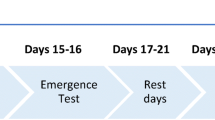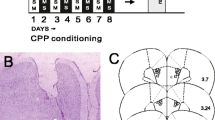Abstract
Rationale: The prefrontal cortical (PFC) dopamine (DA) system has been implicated in anxiety-related behavioral changes, but direct, unequivocal support for this idea is sparse. Objectives: The present aim was to study the functional significance of prefrontal DA using the pentylenetetrazol (PTZ) discrimination model of anxiety. A comparison was made with its role in the cue of the anxiolytic drug chlordiazepoxide (CDP). Methods: Two groups of rats were trained to discriminate either PTZ (20 mg/kg, s.c.) or CDP (10 mg/kg, i.p.) from saline using an operant drug discrimination procedure. After prolonged training, half of each group was used to assess biochemical changes induced by both drugs in different sub areas of the PFC. For the remaining rats, discrimination training continued and generalization tests with PTZ and CDP were performed. Rats were then provided with bilateral guide cannulae aimed at the ventromedial (vm) PFC, and the effects of local infusions of DAergic drugs on discriminative performance were evaluated. Results: CDP did not affect PFC DA activity, but PTZ increased the DOPAC/DA ratio in the vmPFC selectively. Generalization tests showed that the cues of PTZ and CDP were dose dependent. In PTZ-trained rats, infusions of the DA receptor antagonist cis-flupenthixol into the vmPFC blocked the PTZ cue dose dependently, whereas the agonist apomorphine partially generalized to this cue. In CDP-trained rats, neither drug antagonized or generalized to the CDP cue, showing that PFC DA is not critically involved in the CDP cue and that local pharmacological manipulations of PFC DA do not affect discriminative abilities per se. Conclusions: The DAergic innervation of the PFC is directly involved in the behavioral effects of PTZ, suggesting a role for it in anxiety.
Similar content being viewed by others
Author information
Authors and Affiliations
Additional information
Received: 26 July 1999 / Final version: 9 January 2000
Rights and permissions
About this article
Cite this article
Broersen, L., Abbate, F., Feenstra, M. et al. Prefrontal dopamine is directly involved in the anxiogenic interoceptive cue of pentylenetetrazol but not in the interoceptive cue of chlordiazepoxide in the rat. Psychopharmacology 149, 366–376 (2000). https://doi.org/10.1007/s002130000390
Issue Date:
DOI: https://doi.org/10.1007/s002130000390




